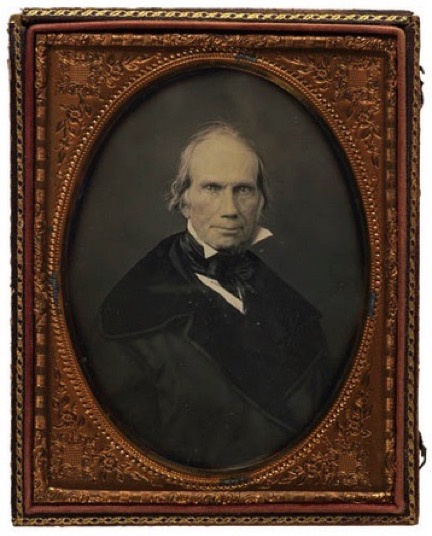half plate daguerreotype of Henry Clay
(CLAY, HENRY.) Montgomery Simons, attr. Henry Clay, half plate daguerreotype
[Philadelphia], c. 1848
Half plate daguerreotype. Leather case.
A classic, characteristic daguerreotype portrait of Henry Clay, the “Great Compromiser,” a dominant force in American politics for decades. He represented Kentucky in Congress from 1806 until his death in 1852, with a few breaks for cabinet duty or a presidential campaign–he ran four times without success. A political moderate, he brokered the Compromise of 1850 that kept the United States intact.
A nearly identical portrait of Clay was copyrighted by Philadelphia photographer Montgomery P. Simons. Simons wrote to the Photographic Art Journal in 1853 to discuss this sitting:
“My likeness of Mr. Clay, which has elicited so many encomiums from the press, and which you have been pleased to criticise so favorably, as a valuable likeness, is still more valuable for having associated with it a pleasing and characteristic anecdote of that great statesman. This anecdote made such a strong impression upon my memory, as being a most elegant impromptu, that I am now able to give it to you verbatim, although it has been several years since it happened. At the time I took the picture of Mr. Clay, he was on a visit to Philadelphia, and the guest of one of his warmest friends, Mr. Potter, who accompanied him to my Gallery.
“As Mr. Potter and myself were about arranging Mr. Clay’s drapery, I asked him if he had any choice of position; his answer was, ‘None whatever, sir; I am Clay in the hands of a Potter, let him mould me as he will.’”
“Henry Clay of Kentucky had one of the most superlative political careers in American history. A lawyer by training, Clay served in almost every level of government possible in the 19th century: the Kentucky state house of representatives, the United States Senate, the United States House of Representatives, and the executive branch as Secretary of State. On top of that, he helped negotiate the Treaty of Ghent ending the War of 1812, and ran for President three times over three decades on three different party tickets (Democratic Republican Party, 1824; National Republican Party, 1832; and the Whig Party, 1844).
“Despite being a political journeyman, Clay’s true home, he confessed, was in the House. He served as Speaker—and resigned from the Speakership—on three separate occasions, but the exact timeline of his House career isn’t as straightforward as we might expect from one of America’s foremost statesmen. The Kentuckian had served in the Senate twice before capturing a seat in the House in 1810, promptly winning election as Speaker on the first day of his first term” (House of Representatives website).
Provenance: early ink inscription on verso: “”given by Henry Clay to Isaac Fuller.“ By descent from the family of Abbott Fuller Graves; Dennis Waters; Swann Galleries, March 23, 2010, lot 33.
$32,000



